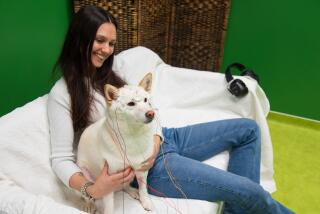Here’s scientific proof that your dog feels you

Anxiety? Excitement? Hopes for a new year? A new study suggests dogs share with humans a knack for interspecies emotional interpretation. They get us.
It’s unlikely to come as a surprise to anyone who has a dog as a best friend, but your dog gets you. He knows when you’re happy. She moves in a little closer when you’re sad. He may not fetch your slippers, but he does seem to sense when you’ve had a truly lousy day at work.
In case you take this amazing feat of interspecies mind-reading for granted -- or you dismiss this belief as sentimental human pap (as many researchers have) -- a new study strongly suggests that the domestic dog does indeed recognize and distinguish among different states of mind in humans.
The research demonstrates that dogs use both facial expressions and voice characteristics as cues to a human’s state of mind. Its authors underscore that while this ability to detect the mood of another is common enough within the same species, our canine companions appear to be unique in sharing with humans the ability to transcend species boundaries in reading emotions.
At least, so far as we know.
Writing in the journal Biology Letters, researchers from the University of Lincoln in Britain and the University of Sao Paolo in Brazil describe a method of demonstrating dogs’ knack for reading the emotions of others. It closely resembles methods used to demonstrate social understanding in pre-verbal human babies.
They presented 17 healthy socialized adult dogs with combinations of images and sounds and gauged which combinations held their attention longest. On two different screens before him or her, the dog would see an image conveying either playful/happy emotion or angry/aggressive emotion. At the same time, he or she would hear a sound that either conformed to the emotion depicted in the image, a sound that conflicted with it, or a sound that was neutral -- essentially static.
The dogs were set to the task of processing images and sounds of other dogs expressing emotions and of humans doing so as well. The length of time that a dog spontaneously looked at an image offered insight into whether the dog effectively attached social meaning to the emotion being conveyed, and whether he or she integrated stimuli from different sources in doing so.
To ensure the dogs weren’t responding to familiar emotional cues, the human vocalizations were in a language none of the dogs was familiar with -- Brazilian Portuguese -- and the faces were unknown to them. They also launched into the trial with no training, so there’d have been little human prod to their preferential looking.
When hearing a happy/playful or an angry/aggressive vocalization, the dogs’ gazes lingered on the correct corresponding image in 67% of the trials -- a much better than random preference for emotionally congruent messages. That preference held steady whether the image and vocalization came from a dog or a human, whether the emotion was positive or negative, and whether the human pictured was male or female.
Significantly, dogs didn’t look at one picture any longer than another when it was accompanied by the sound of static. When image and sound matched, the dogs did, however, look longer at other dogs’ faces than they did at humans’ faces in the same circumstances.
The ability to read intent or motivation on another’s face is a powerful survival tool for any species: to do it well within one’s own species would clear the way for social organization and the further survival benefits that living as a group offers. A dog with a knack for recognizing humans’ emotions would have a leg up in enlisting protection, shelter and even food from humans. And as domestication of dogs spread among human communities, selective breeding, even if it were not consciously done, would have favored that trait, the authors suggest.
The ability to derive significant emotional information by integrating visual and auditory cues “suggest[s] cognitive capacities not previously demonstrated outside of primates,” the authors wrote. “Further, the ability of dogs to extract and integrate such information from an unfamiliar human stimulus demonstrates cognitive abilities not known to exist beyond humans.”
These remarkable skills “may be fundamental” to allowing dogs to live and flourish within the “mixed species social groups” in which so many live, they added.
Follow me on Twitter @LATMelissaHealy and “like” Los Angeles Times Science & Health on Facebook.







